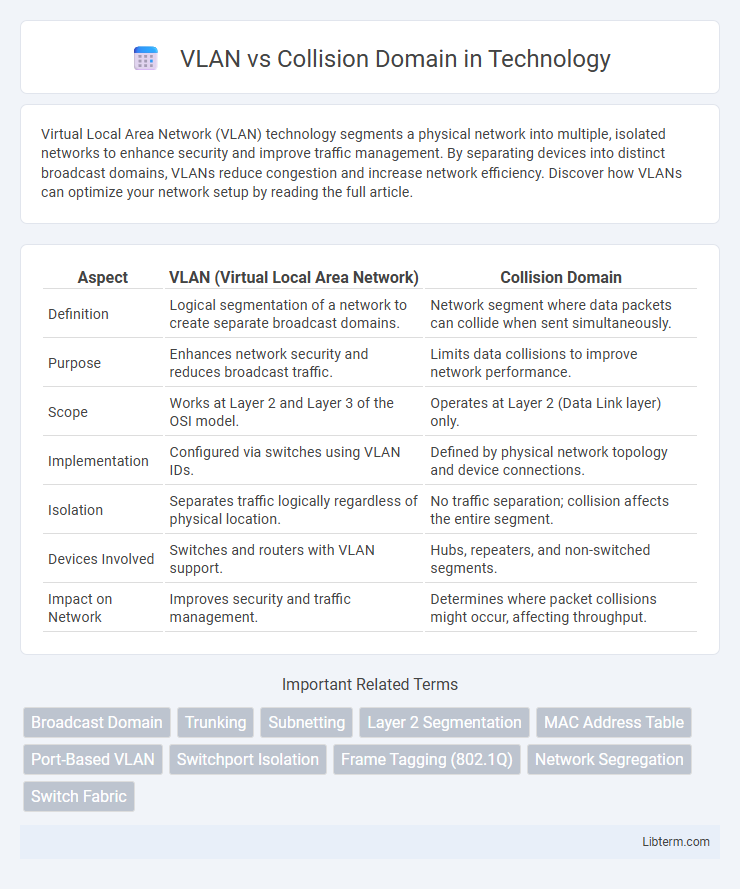Virtual Local Area Network (VLAN) technology segments a physical network into multiple, isolated networks to enhance security and improve traffic management. By separating devices into distinct broadcast domains, VLANs reduce congestion and increase network efficiency. Discover how VLANs can optimize your network setup by reading the full article.
Table of Comparison
| Aspect | VLAN (Virtual Local Area Network) | Collision Domain |
|---|---|---|
| Definition | Logical segmentation of a network to create separate broadcast domains. | Network segment where data packets can collide when sent simultaneously. |
| Purpose | Enhances network security and reduces broadcast traffic. | Limits data collisions to improve network performance. |
| Scope | Works at Layer 2 and Layer 3 of the OSI model. | Operates at Layer 2 (Data Link layer) only. |
| Implementation | Configured via switches using VLAN IDs. | Defined by physical network topology and device connections. |
| Isolation | Separates traffic logically regardless of physical location. | No traffic separation; collision affects the entire segment. |
| Devices Involved | Switches and routers with VLAN support. | Hubs, repeaters, and non-switched segments. |
| Impact on Network | Improves security and traffic management. | Determines where packet collisions might occur, affecting throughput. |
Introduction to VLANs and Collision Domains
VLANs (Virtual Local Area Networks) segment a physical network into multiple logical networks, enhancing security and reducing broadcast traffic by isolating devices within specific VLANs. Collision domains define network areas where data packets can collide when sent simultaneously, primarily seen in traditional Ethernet hubs, which can cause network inefficiencies. Implementing VLANs reduces size and impact of collision domains by logically grouping devices and limiting unnecessary traffic, improving overall network performance.
Definition and Purpose of VLANs
A VLAN (Virtual Local Area Network) is a logical subdivision of a physical network that groups devices to enhance security, reduce broadcast traffic, and improve network management. Unlike collision domains, which represent network segments where packet collisions can occur, VLANs segment broadcast domains at the data link layer to isolate network traffic efficiently. The primary purpose of VLANs is to create multiple distinct networks within a single physical infrastructure, enabling better control over network resources and minimizing congestion.
What is a Collision Domain?
A collision domain is a network segment where data packets can collide when devices transmit simultaneously, typically occurring in hubs or half-duplex environments. VLANs (Virtual Local Area Networks) logically segment networks to isolate broadcast domains but do not inherently reduce collision domains. Understanding collision domains is crucial for optimizing network performance, as reducing the size of collision domains with switches minimizes packet collisions and improves data flow efficiency.
How VLANs Segment Network Traffic
VLANs segment network traffic by creating distinct broadcast domains within a single physical switch, isolating traffic to improve security and reduce congestion. Each VLAN operates as an independent logical network, preventing packets from one VLAN from reaching devices in another without routing. This segmentation limits collision domains to switch ports, enhancing network efficiency compared to traditional collision domain boundaries.
Role of Collision Domains in Network Performance
Collision domains define network segments where data packets can collide, impacting throughput and latency. VLANs segregate broadcast domains but do not inherently reduce collision domains unless combined with switches that isolate collisions. Reducing collision domains through switched networks improves performance by minimizing packet collisions and retransmissions.
Key Differences: VLAN vs Collision Domain
VLAN (Virtual Local Area Network) segments a physical network into multiple logical networks to improve security and traffic management, while a collision domain is a network segment where data packets can collide during transmission, typically in Ethernet networks using hubs. VLANs isolate broadcast domains by assigning ports or devices to distinct virtual networks, reducing unnecessary traffic and enhancing control, whereas collision domains are limited by physical hardware boundaries where only one device can successfully transmit at a time. VLANs operate at Layer 2 of the OSI model to manage traffic logically, whereas collision domains are a fundamental concept related to Ethernet network design affecting data transmission efficiency.
Impact on Network Security
VLANs enhance network security by segmenting a large broadcast domain into isolated subnetworks, reducing unauthorized access and limiting the scope of potential attacks within a collision domain. Collision domains refer to network segments where data packets can collide, primarily affecting performance rather than security, but VLANs minimize security risks by logically separating traffic even within the same physical collision domain. Implementing VLANs restricts broadcast traffic and enforces access control policies, significantly strengthening network security compared to relying solely on collision domain boundaries.
Scalability: VLANs Compared to Collision Domains
VLANs significantly enhance scalability by allowing network segmentation at the data link layer, enabling multiple virtual networks within a single physical infrastructure. Unlike collision domains, which are limited by physical network boundaries and increase collision risk as more devices connect, VLANs isolate broadcast traffic, reducing congestion and improving overall network performance. This logical separation supports larger, more flexible networks by simplifying management and enhancing security across distributed environments.
Best Practices for Network Design
VLANs segment networks logically, improving security and performance by isolating broadcast domains, whereas collision domains are physical areas where packet collisions occur, typically confined within a switch port or hub segment. Best practices for network design recommend using VLANs to minimize broadcast traffic and organize devices by function or location, while deploying switches to reduce collision domains by providing dedicated bandwidth per port. Proper VLAN configuration combined with switch port isolation enhances network efficiency, reduces congestion, and simplifies troubleshooting in enterprise environments.
Conclusion: Choosing Between VLANs and Collision Domains
Choosing between VLANs and collision domains depends on network design goals and scalability needs. VLANs provide logical segmentation of broadcast domains, enhancing security and traffic management across multiple switches. Collision domains, limited by physical boundaries, mainly reduce packet collisions but do not isolate traffic, making VLANs the preferred choice for modern, scalable network architectures.
VLAN Infographic

 libterm.com
libterm.com